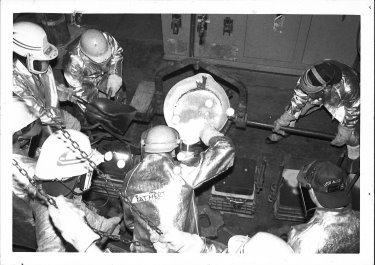A Foundry Career, First Forged in the Navy
Lydia Engelbreth and Emily Schutte | Waupaca Foundry Phil Eatherton, current HR Manager, on one of his deployments on the USS Acadia.
Phil Eatherton, current HR Manager, on one of his deployments on the USS Acadia.Upon graduating high school in Stephenson, Michigan, Phil knew he wanted to go straight to work. After trying out a few jobs and not hitting his stride, his father encouraged him join the military. Phil comes from a long line of military service, starting with his great-grandfather. So, in 1990, Phil became the fourth generation of Eathertons to enlist.
Phil joined the U.S. Navy and completed bootcamp at the Naval Station Great Lakes (NSGL) in Illinois. During the 7-week bootcamp, recruits are expected to pick a line of work for their accession training. Known as A School, accession training is the technical training for a sailor’s military occupational specialty (MOS) field.
Phil recalls, “I remember sitting there watching 10-second clips of all of the jobs that existed. There were so many options because each ship acts as a small city. All of a sudden, I caught a clip of molten iron being poured. It was bright and exciting, and I knew that was it.”
Phil’s A School choice was also influenced by his familiarity with Waupaca Foundry. He knew that when his four years in the service were up, he wanted to apply to the company when he returned to Michigan. Waupaca Foundry had been a staple of his hometown and he could see himself continuing his foundry career, there.
At that time, A School for foundry work was held just once a year – and by a stroke of good luck, the next training began two weeks after Phil finished bootcamp. For a guy that didn’t want to go to school, Phil embraced the full-time, 5-month A School training. During the training, sailors learn the basics of foundry work, study different types of metals, and keep up with other military expectations such as endurance, exercise, and weaponry.
After completing A School, Phil stationed at the 32nd Street Naval Base in San Diego, California with the USS Acadia, his home for the rest of his military career. Half of that time was spent at sea. His service included two tours in the Persian Gulf, the first in 1992 and the second in 1993/1994. These were to help the United States maintain a presence and keep the peace after Operation Desert Storm.
As a Molder, Phil and his team were responsible for all the repairs and casting needs for the squadron of ships that went along with the USS Acadia. The ship included a machine shop, a foundry, an area for non-destructive testing (NDT), a weld shop, and an engine shop. Phil worked with all different types of metals, both ferrous and non-ferrous. Unless it is an emergency, all pouring and casting work is completed while the ship is moored in port.
After nearly four years in the Navy, Phil discharged and relocated back to Michigan. He enjoyed his time in the service but knew it wasn’t meant to be his long-term career. As planned, Phil immediately applied to Waupaca Foundry and landed a role as a second shift worker in the mill room. His dream job came two years later when he was promoted to the melt refractory, where he spent 10 years, before he transitioned to a safety role that required him to develop a Behavioral Based Safety Program. Three years later, Phil moved into human resources, whe.re he is now the manager.
Those four years in the Navy taught Phil about attention to detail, preparedness, and the value of relationships – not to mention the hands-on skills of foundry work. These skills are invaluable to a Waupaca Foundry team, and we are grateful that Phil has dedicated the last 27 years to our company.
Waupaca Foundry is proud to employ many men and women who are veterans. Ten percent of our employees have served in uniform, and we thank you for your service.


We use cookies and other tracking technologies to personalize content and analyze our site traffic. More information about this is in our Privacy Policy. You can control third party cookies by adjusting your browser settings.